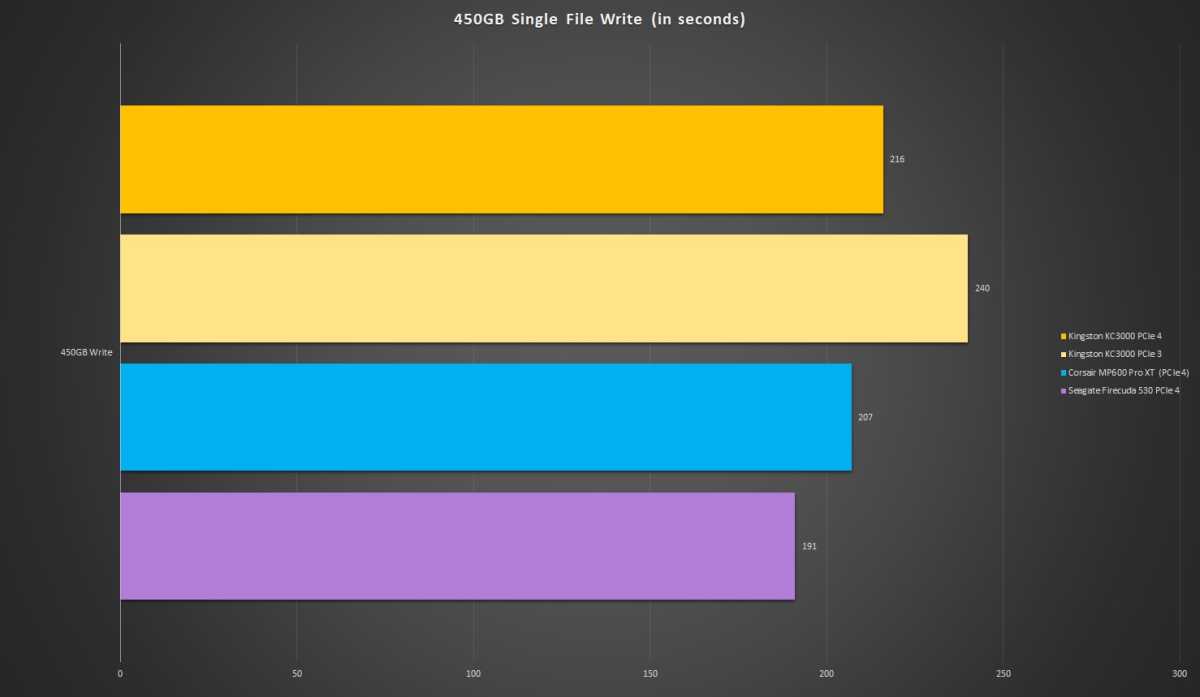
 Image: Kingston
Image: Kingston
 At a glance
At a glance
Expert’s Rating
Pros
Excellent, top spot performanceAffordable for a PCIe 4 NVMe SSDAvailable from 512GB to 4TBFive-year warranty
Cons
Could have a higher TBW rating
Our Verdict
The KC3000 is as good as NVMe SSDs get in both performance and price. The best thing going at the moment, though by only a hair over the Seagate FireCuda 530 and Corsair MP600 Pro XT.
Price When Reviewed
512GB for $107 | 1TB for $175 | 2TB for $400 | 4TB for $1000
Best Prices Today: Kingston KC3000 NVMe SSD
RetailerPriceKingston$106.99View DealPrice comparison from over 24,000 stores worldwideProductPricePrice comparison from Backmarket
Man, was the Corsair MP600 Pro XT‘s reign as top dog short. Only a couple of weeks after taking the performance crown (sort of), it loses it to the Kingston KC3000, the new best SSD in the land. True, Corsair didn’t lose the title by much, and it wasn’t a total shock given that both use Phison’s latest E18 controller and 176-layer TLC NAND. Still, our sympathy to Corsair and congratulations to Kingston.
And congrats to you as well. You now have three lightning-fast PCIe 4 NVMe SSDs to choose from when you include Seagate’s FireCuda 530. Just make sure you have a fairly modern computer that can support PCIe 4.0 before you splurge on one of these hotrods.
This review is part of our ongoing roundup of the best SSDs. Go there for information on competing products and how we tested them.
Price and specs
The KC3000 is available in 512GB, 1TB, 2TB, and 4TB flavors for $107, $175, $400, and $1000, respectively. That’s basically on par with the MP600 Pro XT, but shop carefully as you might find one or the other cheaper at a particular capacity. The KC3000 is warrantied for five years and carries a slightly larger TBW rating than its Corsair rival: 400TBW for the 512GB model, 800TBW on the 1TB, 1.6PBW (PetaBytes Written–a petabyte is 1000 terabytes), and 3.2PBW on the 4TB capacity.

The KC3000 is your standard 2280 (22 mm wide, 80 mm long) form factor commercial NVMe SSD. I’ve already given away the controller and NAND, however, there’s also 1GB of primary DRAM cache for every 1TB of capacity.
Secondary caching is the main TLC employed as SLC, i.e., data is written to it as a single voltage level (one bit), rather than one of fifteen (three bits). How the amount of TLC as SLC required is determined wasn’t disclosed, but whatever is being done, it’s being done extremely well. The only fluctuations of note were exceedingly minor and occurred during the 450GB sustained write.
Performance
The numbers rolling out of the benchmarks and off the stopwatch for the KC3000 were hauntingly familiar—I just saw them from the aforementioned Corsair MP300 Pro XT. Indeed, the difference in speed between the KC3000, Corsair, and Seagate FireCuda 530 is hardly worth mentioning. It’s so close, you should buy on price and other factors. Still, as you’ll see below, the KC3000 is the fastest of the three in CrystalDiskMark and our 48GB transfer tests—though only by a gnat’s eyebrow.
Note that the lighter gold is the KC3000’s performance over PCIe 3. I’ve included it because, well, I’ve been asked to by readers. Buying a PCIe 4 drive for a PCIe 3 PC is a waste of money unless you plan to take it forward with you to a newer PC.

As you can see above, the KC3000 bested both its rivals in CrystalDiskMark 6 by a small margin. Note that we do test using CrystalDiskMark 7 and AS SSD, however, for comparison with older drives, we stick with the version 6 CDM results, which are still perfectly valid.

The KC3000 was the fastest by a mere second at our 48GB transfers shown above. But fastest is fastest; every second counts; you’re not getting any younger…

The only test where the KC3000 fell marginally off the pace was in our 450GB sustained write—something most users won’t do very often, if ever. 3 minutes and 36 seconds is still a very fast time.
The PCIe 3 tests utilize Windows 10 64-bit running on a Core i7-5820K/Asus X99 Deluxe system with four 16GB Kingston 2666MHz DDR4 modules, a Zotac (Nvidia) GT 710 1GB x2 PCIe graphics card, and an Asmedia ASM3242 USB 3.2×2 card. It also contains a Gigabyte GC-Alpine Thunderbolt 3 card, and Softperfect Ramdisk 3.4.6 for the 48GB read and write tests.
The PCIe 4 testing was done on an MSI MEG X570 motherboard socketing an AMD Ryzen 7 3700X 8-core CPU, using the same Kingston DRAM, cards, and benchmark software. ImDisk replaces Softperfect as the RAM disk. All testing is performed on an empty, or nearly empty drive that’s TRIM’d after every set of tests.
Write performance will decrease as the drive fills up. In some rare cases, components may change for the worse. Kingston has been accused of substituting slower parts before. If your drive, given similar hardware, does not perform as well as our test unit, please let us know.
Conclusion
The Kingston KC3000 we tested is a fantastic NVMe SSD that’s fast via PCIe 3 or 4. As mentioned, it’s pretty much a pick ’em with the Corsair MP600 Pro XT and Seagate FireCuda 530. Base your decision on price, TBW, warranty, availability, or which company you prefer. You’ll love any of the three.
Best Prices Today: Kingston KC3000 NVMe SSD
RetailerPriceKingston$106.99View DealPrice comparison from over 24,000 stores worldwideProductPricePrice comparison from Backmarket
Author: Jon L. Jacobi, Freelance contributor

Jon Jacobi is a musician, former x86/6800 programmer, and long-time computer enthusiast. He writes reviews on TVs, SSDs, dash cams, remote access software, Bluetooth speakers, and sundry other consumer-tech hardware and software.
Recent stories by Jon L. Jacobi:
SanDisk Desk Drive USB SSD review: High capacity, 10Gbps performanceSK Hynix Tube T31 review: Looks like a USB drive, performs like a SSDTeamgroup Z540 review: A worthy competitor for the SSD performance crown




